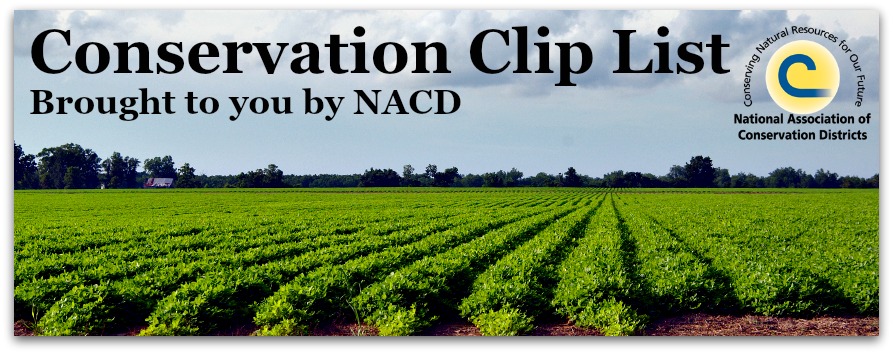
Conservation Clip List is a weekly collection of articles distributed by NACD that provides our members and partners with the latest news in what's driving conservation. If you have a relevant submission, please contact your NACD Communications Team.
NRCS rolls out regs for new Ag Conservation Easement Program via Agri-Pulse
Fewer acres would be purchased as easements to protect wetlands and other sensitive lands under the new Agricultural Conservation Easement Program (ACEP), which is replacing three programs repealed by the 2014 farm bill. The amount of funding available and the increase in per-acre costs will result in a corresponding decrease in acreage enrolled under ACEP.
Court mandates new recovery plan for Mexican gray wolves via The Washington Post
Federal wildlife officials are now under a court order to update a decades-old recovery plan for the endangered Mexican gray wolf, a predator that has struggled to regain a foothold in the American Southwest despite millions of dollars of investment in reintroduction efforts.
As California Water Use Rises, Some Ask: Were Limits Eased Too Soon? via The New York Times
The state slashed urban water use over 25 percent in the face of a punishing drought last year, exceeding a mandatory order issued by Gov. Jerry Brown and turning California into a model of water conservation. But this year, after regulators lifted the mandatory 25 percent statewide cut following a relatively wet winter, water use is up again, a slide in behavior that has stirred concern among state officials and drawn criticism that California abandoned the restrictions too quickly.
Open Mic: Bill Buckner, President, Samuel Roberts Noble Foundation via Agri-Pulse
(Audio) In this interview, Buckner outlines a national effort to develop a standardized condition rating and testing for soil health. A standardized numeric value could help producers embrace agronomic practices, technology, and cropping systems which could eventually be tied to risk protection plans and crop insurance as well as the overall value of farmland.
Farm to ‘Put a Fork in It’: Why We Can’t Afford to Polarize the Next Farm Bill via The Huffington Post
(Opinion) Conservation programs assist farmers and ranchers in implementing sustainable practices and programs on their operations, protecting our environment and natural resources. Farmers and consumers alike share concerns about the effects of our changing climate, and it’s important to get the agriculture industry involved in solutions to mitigate climate change. It is our moral obligation, rather than our political impulse, that should motivate improvements to food and farm policy programs this election season and in the next Farm Bill cycle.
South Carolina’s forest products industry seeks to grow exports to key, emerging markets via The Post and Courier
A growing, consumer-driven middle class, a burgeoning furniture industry, and stepped up efforts to protect its own forests are driving the growth of wood product shipments to China from the Port of Charleston and other U.S. markets, a panel of global business experts said Monday.
White Paper Lists Recommendations For Great Lakes Cleanup Program via Wisconsin Public Radio
A mix of industry, tribal, regulatory, and environmental stakeholders have released a white paper listing a dozen recommendations for the future of a federal Great Lakes cleanup program. More than $2 billion has been spent cleaning up toxic hotspots along the Great Lakes over the last six years, but stakeholders believe it needs a long-term funding commitment.
Falconers hired to discourage other birds from eating crops via The Washington Post
Frustrated growers tired of seeing wild birds devastate their fruit crops are turning to raptors to patrol their fields, orchards, and vineyards. Falconers train their birds to intimidate rather than destroy, since state or federal laws protect all but a few bird species.
Settlement deal possible in Oregon Clean Water Act lawsuit via Capital Press
Earlier this year, the federal government filed a complaint alleging that farmer Bill Case of Albany, Ore., discharged pollutants by placing large rocks within the high water mark of the North Santiam River. The bank stabilization has actually reduced pollution in the river by preventing erosion, according to Case. The EPA’s lawsuit seeks up to $37,500 in fines per day for the alleged violations — which it claims stretch back to 2009 — as well as returning the riverbank to its original condition.
EPA gets an earful at Superfund 5-year-review meeting via Montana Standard
The message to the Environmental Protection Agency at a public meeting Monday at the Mining City Center was clear: Butte’s Superfund cleanup and the document that evaluates it is inadequate. Many of the caps — vegetation and soil placed over mine waste — on the Butte Hill are not working or were not addressed in the first place.
Oregon barn fire leads to wetland dispute via Capital Press
The underlying problem is that state and county maps may show that a property isn’t a wetland, but that doesn’t necessarily mean the Department of State Lands can’t later determine it’s actually a wetland. After he attempted to rebuild upon his land, an Oregon resident said the agency effectively declared the area a wetland and then forced him to prove it’s not.